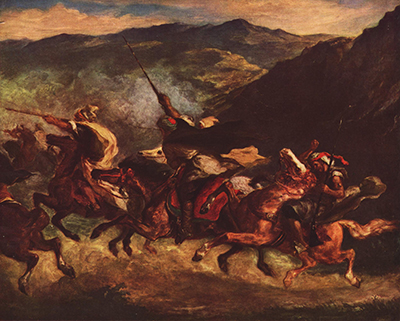Moroccan Fantasia is dated at 1847, and was completed by Eugene Delacroix as part of his interest in the life and culture of this exotic region in North Africa. Many of the depictions that he produced involved soldiers on horseback, as found here.
Delacroix liked to darken many of these scenes which creates a memorable atmosphere, but can make it harder to actually spot specific details when looking at images of the original artwork. Several soldiers charge across a pathway in the foreground, with rolling hills displayed across the background. All of these men are on horseback and appear to be moving at great speed. The artist loved to include movement within his paintings, and that was one of the symbols of the Romanticist movement, although it was a hard craft to achieve within static oil paintings. We see the horse hooves trampling across the ground and can imagine the noises created by this scene, as well as the fear felt by anyone who stood in their way. The artist would paint horses many times in his career and would also sketch them in person in order to best understand their unique frame and personality.
The artist's highlights included the likes of Women of Algiers, Barque of Dante and Orphan Girl at the Cemetery from a long and distinguished career in which it can be said with certainty that he truly mastered a number of different genres. He worked with religious themes as well as the foreign influences as found here. He was dramatic, but also highly skilled in a technical sense and constantly new challenges as his career developed. Delacroix remains seen as an integral member of the Romanticist movement in which literature and art ran together in unison and emotion and expression became important attributes of any artwork, helping lead us towards the styles of the 19th and 20th century.
The artist would, of course, focus on Moroccan culture many times within his career besides just the painting displayed here. He seemed enchanted by different elements, such as the clothing, the history and also the landscapes found in that region. Other examples would include Moroccan Horseman Crossing a Ford and Moroccan Saddling a Horse, though he made use of the theme many more times than that. It was an important body of work within European art, helping more of the public to understand about these alternative cultures for perhaps the first time in some cases. Other artists would do much the same, though focusing on other regions of the world, such as the Middle East or Japan, for example. This was a sign of the world starting to become smaller, with a greater interaction between the different regions as European powers spread their influence into new regions of the world.




